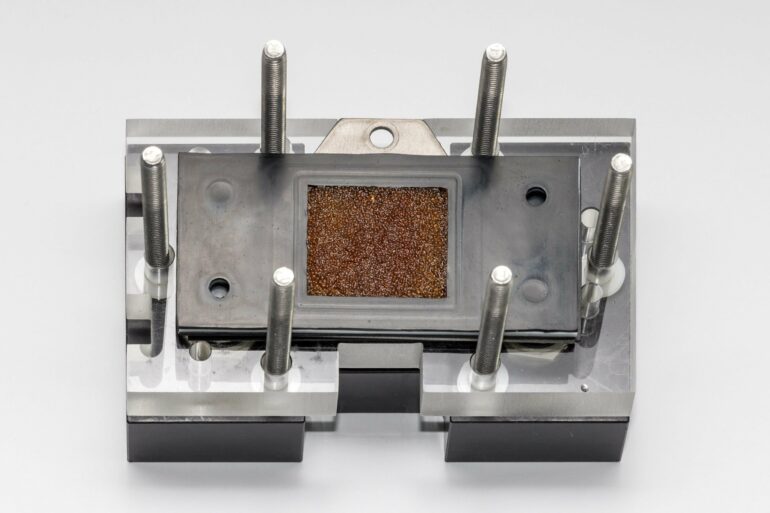Coal in the Rhenish region is not only an important fuel for power generation. It is also used by the chemical industry to produce important basic chemicals. But by the time of the coal phase-out these substances will have to be obtained from other renewable sources. One example is carbon monoxide, or CO for short, which is needed for the production of certain plastics and acetic acid.
For this, scientists at Forschungszentrum Jülich are working on a climate-friendly technology based on renewably generated power. Using CO2 electrolysis, the greenhouse gas CO2 is converted directly into carbon monoxide. The researchers have now overcome an important hurdle and developed a scalable cell stack for large-scale applications.
The research is part of the structural change project iNEW, which is intended to promote the growth and preservation of jobs in the Rhenish region by introducing renewable based processes.
“CO is usually produced on site by industry on a large scale. It is difficult to transport because it is a toxic and highly flammable gas,” explains Maximilian Quentmeier, graduate student at the Jülich Institute for Energy and Climate Research (IEK-9). Commonly, coal is burned with oxygen under supply to produce the gas.
But after the coal phase-out, other processes will be needed instead. In the future, CO will still be needed as a basic chemical. Among other things, it is required for the production of polycarbonates and polyurethanes, which are used, for example, to make eyeglass lenses and insulating panels.
Together with his supervisor Bernhard Schmid, Maximilian Quentmeier is working on a process that is also known as CO2-to-CO-electrolysis. The approach uses a so-called gas diffusion electrode: a porous electrode that is fed with CO2 on the back side and is adjacent to a liquid or solid electrolyte on the front side. The electrode connects the two media and the electric current and thus ensures that “green” carbon monoxide, CO, is produced in the end.
Possible climate-negative path
The process not only appeals to the chemical industry, but also contributes to the climate protection . ” When operated with renewably produced power, CO2 electrolysis plants would operate climate-neutrally . If the carbon dioxide is sourced from the atmosphere, for example by direct air capture, or from the workup of biogas, the technology is even potentially climate-negative,” explains Bernhard Schmid.
All in all, the technology could help to actively reduce the CO2 concentration in the atmosphere. “In principle, future renewable plastics become a carbon sink similar to wood,” says Bernhard Schmid.
Milestone achieved towards practical application
Quentmeier and Schmid have already reached an important milestone on the way to commercialization. They have succeeded in transforming the the single cell to a stack type electrolyzerby making multiple improvements and replacing components, and have tested it in various performance tests. The results were recently published in ACS Sustainable Chemical Engineering.
In a stack, the cells are compactly packed on top of each other. A stack of smaller cells is much cheaper to manufacturecompared to a large single cell. “There are several aspects to consider when designing a stack starting from a single cell. For instance, the cells for the gas reaction have multiple chambers which ar typically unsupported in laboratory size.. The cells of a stack must withstand compression force and at the same time remain permeable,” explains Maximilian Quentmeier.
Under the assumption of realistic process conditions, the Jülich researchers optimized the design of the gas flowfield and electrical current collector for this purpose. Instead of the usual liquid electrolyte, a solid flow through polymer electrolyte made of ionically conductive synthetic resin is used as a supporting element, which structurally supports the electrolyte gap.
Thanks to a clever anode design, the researchers were also able to completely omit the electrolyte chamber between the membrane and the anode. For the stack, the positive and negative electrodes, cathode and anode, of adjacent cells were replaced by a single component (the bipolar plate) that connects two cells..
In the current experimental set-up using modular components which are not optimized for efficiency, the stack achieves an efficiency of 30%. “For this type of process, which already operates below 100°C, it is already a quite promising result,” explains Institute Director Prof. Rüdiger-A. Eichel.
“Compared to high-temperature co-electrolysis, for example, plant design is relatively simple and produced pure CO instead of synthesis gas which further simplifies processing for many applications. Thus, a decentral supply of the platform chemical CO can be provided to the industrial companies in the Rhenish region, saving transport cost,” says Rüdiger-A. Eichel. The next steps are further developments and improvements in efficiency to bring the cell stack to the final stage of readiness for mass production.
More information:
Maximilian Quentmeier et al, Toward a Stackable CO2-to-CO Electrolyzer Cell Design─Impact of Media Flow Optimization, ACS Sustainable Chemistry & Engineering (2023). DOI: 10.1021/acssuschemeng.2c05539
Provided by
Forschungszentrum Juelich
Citation:
Carbon dioxide electrolysis as an alternative to coal (2023, March 17)



